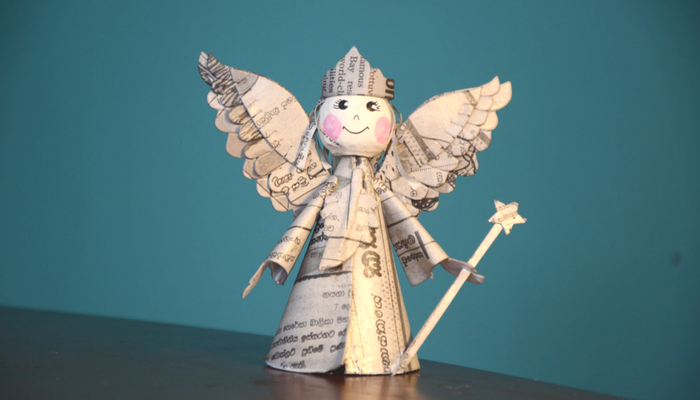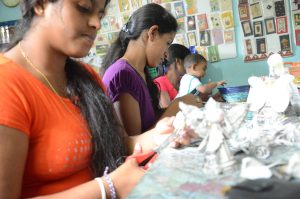Why Crowdfund a Social Enterprise?

Because you can change a life and empower a community for generations.
If you’re a long time Next Chapter community member, you may remember one crowdfunding campaign in particular. One which, due to overwhelming support and generosity (and some really great products!), we as a community were able to help build a safe and stable working environment for artisans in Sri Lanka.
Knots and Strokes had been carrying their popular Angels and Reindeers for a couple of years when in 2014 operations were affected…
We’ll let Sharon Vipond, Founder of Knots and Strokes tell you her story.
Christmas 2017 marks Knots & Strokes fifth anniversary for carrying these unique and now iconic recycled newspaper Angels and Reindeer, each carefully hand crafted by women paper artisans in Sri Lanka.
Some of you may recall how in 2014, the fall monsoons were heavy, persistent, and tenacious. This was hugely unfortunate for these artisans as many steps in the process of making these items was happening outside. Obviously, production was curtailed, orders went unfilled, wages were lost and household livelihoods jeopardized.
As devastating as it was, this weather-related disaster became the catalyst for building a workshop to secure jobs and future production - rain or shine. After a successful crowdfunding campaign in 2016 with Next Chapter, we were able establish this workshop but the story doesn’t end there.
Best yet for the artisans? No more fear of rain damaging the products or slowing production; no more fear of wage loss due to inability to work in the rainy season; and, no more fear of cancelling orders and losing customers due to rain. For two years now not only have all orders for Christmas Reindeer and Angels been made and delivered on time, demand has risen due to this reliability and now more women than ever have full employment.
This year they will have made by hand nearly 10,000 Reindeer and 8,000 Angels. Now, that is a good news story!
The effects of Sharon's crowdfunding are far reaching for this community of artisans in Sri Lanka. Not only has production increased, but so has health and attendance at schools. With a more steady income, children can go to school with a full stomach. Sharon also told us that debt was rampant among the artisans but now with sustained income and education on financial matters the women are less vulnerable to loan sharks and can take microloans from the enterprise instead.
Now you're wondering where you can get one of these to deck out your halls this season, right? Well, Knots and Strokes will be at the Ritz Carlton Christmas Market December 8th & 9th. Or, you can shop online here.
Sharon shared with us a conversation had with the manager of the workshop. So, read on to learn more about the production of these unique Christmas ornaments
How many Angels on average can be produced in an hour or in a day by one lady?
The uniqueness of our products makes them abnormally time-consuming to make so we hardly calculate production capacity as 100% accurate. However, the reasonable time estimate we use for calculating our time to fill customer orders is 20-30 minutes, with a safe estimate 2 Angels per hour. Some can produce 3 per hour. We have 15 women artisans in the workshop who are generally able to work nearly 8 hrs per day. In other words, one artisan can produce around 16 Angels per working day. When a large order comes in and all women are creating Angels, we plan on making at least 250/day.
You started making colored Angels for us this year. How much longer does it take to make a colored one?
For the color newsprint Angels, we need to dye and dry them until the color is absorbed. This requires 2 more steps in the production stage. Dying adds on approximately 10 minutes per batch and then they are left to dry in a dry sunny spot in the workshop or outside in fine weather. So, the extra time is not much; the bigger issue is it interrupts the production flow and the ladies must go on to make something else for a day or two until the Angels’ dresses are fully dry and they are ready to have their heads, crowns, and wands added. All in all, it is still probably 2/hour but the production time frame is longer.


The color dye: are the Angels dipped or is it applied by brush after it is made?
The dye is a Non-Toxic color which we combine with water at our workshop. We dip only the dress (body) part of the Angel in the color container and then let them dry in the fresh air and light; no heating or drying devices are used.
To create the face of the Angel, our artisans hand paint the eyes and mouth with watercolors. Each Angel has its own unique facial expression.
Thanks for sharing the Angel making process. I’m now curious, how all this compares to making the Reindeer, a product which you have been making for a few more years than the Angels?
Reindeer production is a bit different to the Angels as there is a multi-step pre-production stage. Firstly we need to make and roll newspaper tubes/straws. Afterwards, one-third is dipped in red dye, one-third in green dye, and the remaining one-third is left uncolored for the white (silver) Reindeer. After dipping, they must completely dry in the natural air/light on indoor racks or, if nice, outside, just as we do for the Angels. Only once the “straws are ready, does the production begin. As the pre-production activities are all batch processes, we do not include that time when calculating the time to actually create a reindeer. The calculation is the time needed once all materials are ready and provided to the artisan: this is approximately 30 minutes. We estimate our workshop output capacity for Reindeer to be 170/day, in comparison to 250 Angels per day.
How many pounds/tons of paper are collected each month?
Monthly, two metric tons of Newspapers are recycled and consumed by production in our workshop.
Is all the newsprint collected from the local village or quite a wide radius?
This collection of paper and the work these artisans do is not exactly related to a single village but is about local women’s communities. There are mainly two communities of women who are supported through making the recycled paper products. One community focuses on pre-production: making the newspaper tubes/straws which are the cornerstone of most of the products (including the frames, bowls, coasters, as well as the reindeer). The other community is responsible for making the products. These communities are rural and within 1 km of the workshop. In addition to the 15 workshop artisans, another 360 women are now able to work from home, on average 4 hours per day.
On average how many angels and reindeer do you make in a year?
Around 8,000 angels and 10,000 reindeer.

--Interview by Sharon, Founder, Knots & Strokes
Nov 2017
